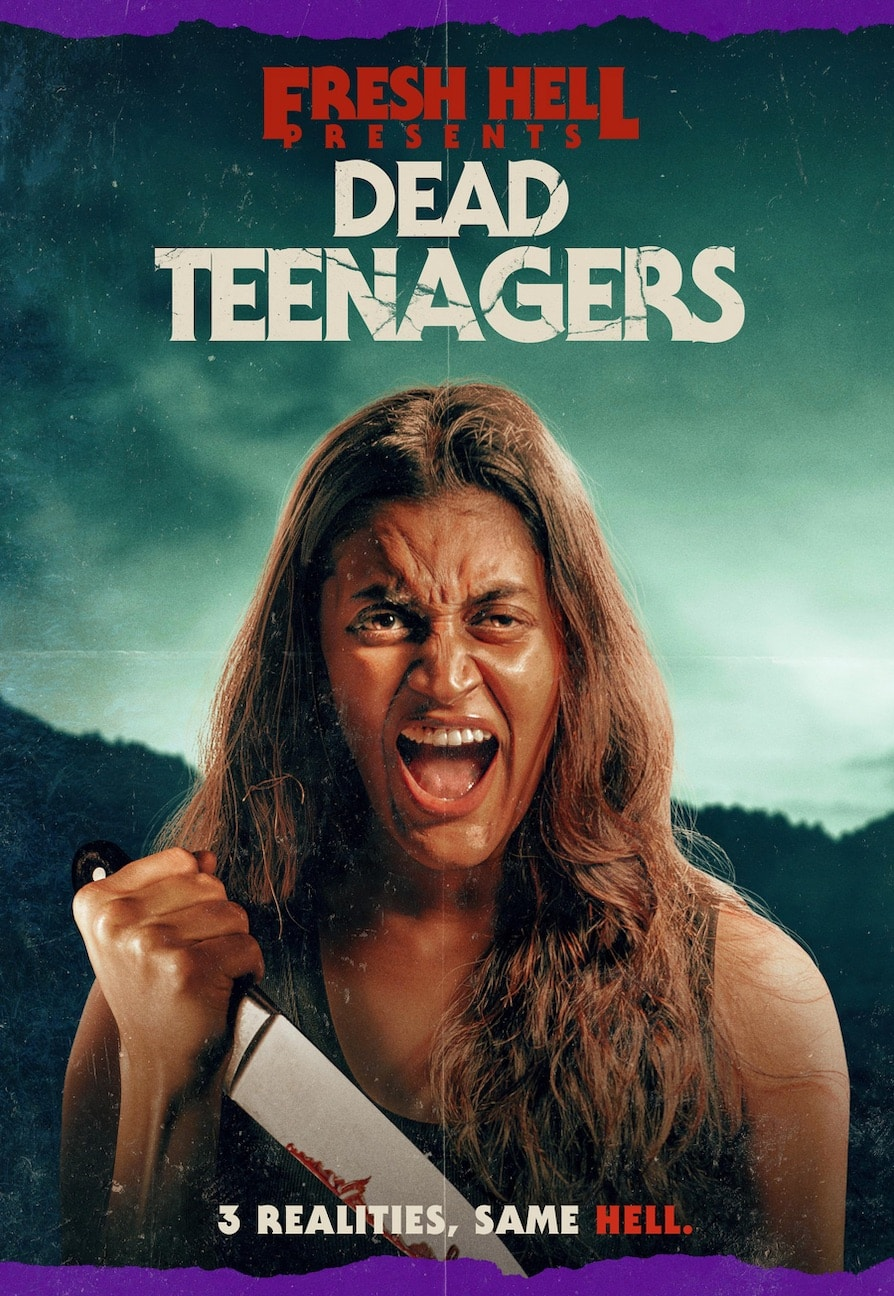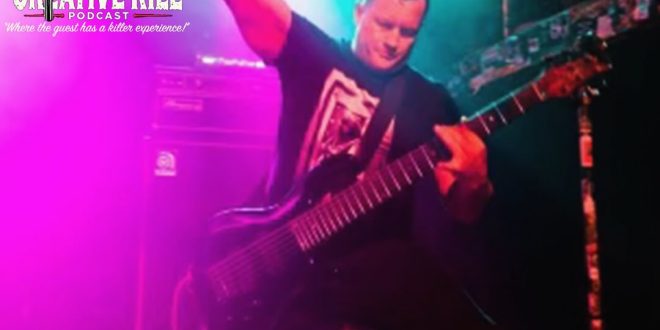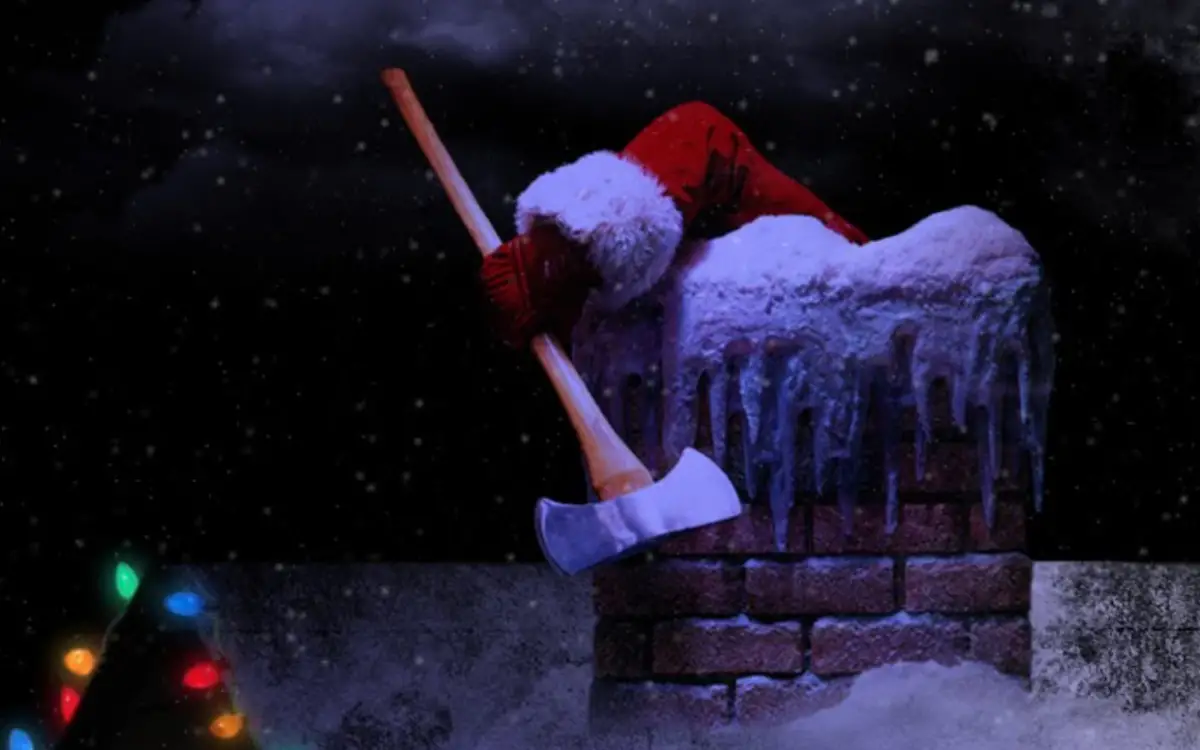David Greathouse On Crafting The World of ‘Fresh Hell’


Writer and director Quinn Armstrong accomplished a massive feat: he and distributor Cranked-Up Entertainment put out three feature horror films in three weeks as part of the Fresh Hell trilogy. Armstrong worked with a small team on small budgets to craft three very different and very bloody horror films: The Exorcism Of Saint Patrick, Wolves Against The World, and Dead Teenagers. Leading the charge when it came to blood and special effects was David Greathouse
Greathouse is a legend when it comes to special effects. He’s worked on films including The Killing Of A Sacred Deer, Wrong Turn (2021), and Tusk, showing his range as a monster-loving artist with a penchant for the bizarre.
Check out the synopses for all three Fresh Hell films below:
The Exorcism Of Saint Patrick: A pastor takes a young gay teen to a cabin to perform conversion therapy. When the pastor goes too far, bullying the kid into suicide, the ghost of his victim returns to plague the pastor and avenge the deaths of so many other ghosts like him.
Wolves Against The World: Two members of a defunct neo-Nazi metal band reunite at the site of their bandmate’s suicide. One sinks into depravity and grievance and one tries to atone for what he has done. What ensues is an occult battle of wills between two men who have done terrible things as one tries to lure the other back into the movement, unleashing the animals that hide inside them.
Dead Teenagers: A masked killer, a cabin in the woods, a group of teens: the basic ingredients of a very old story. But what happens when the story is interrupted? What happens if it keeps going? What do these horror movie archetypes do when they’re thrown into new and unfamiliar situations? Five teenagers are stalked by a killer in the woods. But when the killer accidentally dies, the kids discover they cannot leave until they’ve fulfilled the script of the movie they’re trapped in. They must decide who among them lives and dies.
We spoke with Greathouse about being a blood wizard, creating the grounded horror of all three Fresh Hell films, and his favorite blood gags in the trilogy.
Dread Central: Well, I’m super stoked to chat with you because practical effects are everything to me, and the fact that you did them all for these three films is so cool. So I wanted to hear about first how you heard about this project and where you came in during the process.
David Greathouse: I’ve been friends with producer Phil Garrett for almost 20 years, and he got involved in Kickstarting these three films, and he just reached out to me. He said, “Hey, we’re starting up something here in Ohio with Cranked-Up Entertainment, and we want you involved.” And for lots of stuff, not just practical effects, but future films and producing writing, who knows? The sky’s the limit. So automatically I was interested and three films back to back, man, that was challenging. So yeah, it was basically my friendship with Phil, and then he introduced me to Andy Myers [a producer on the film], and the rest is history.
DC: That’s so cool. Well, I’m curious, before we talk more about your work on this, how did you get into this field?
DG: I’d say the moment was birth. I’ve been obsessed. It’s so early, I don’t know where it started. I’ve been obsessed with monsters since I was about three years old as a child. Just the identification of seeing monster faces, and I really have to give love to my mom and my grandmother. We’re talking in the 1970s and they were yard sale, garage sale junkies. So anytime they came across a doll, a comic book, a picture with anything with a monster face, they brought it home to me. So I was literally spoiled with monsters. They encouraged me!
But obviously growing up in the early 1970s, you had to watch late-night television on Friday and Saturday nights. There were the Universal monsters, the Hammer Horror films, the science fiction films of the 1950s. So as a young child, by the time I was six years old, I knew what I wanted to be. I was going to be the monster in the movies, so it was always that clear. It’s just something that’s been with me my whole life.
DC: That’s so cool though, to see how much you loved monsters at such a young age and you said, “Nope, I’m the monster man.” And then to be the monster man, that’s just so cool to have your dream just come true.
DG: And I mean, they eventually told me that I would grow out of it though, which I never did. I still haven’t.
DC: So what were some films that inspired your work on the three Fresh Hell films in particular and the sensibility that you wanted to go with?
DG: Each film is very different in terms of the scale and what effects were requested, particularly for The Exorcism of Saint Patrick. Even though it’s not in the same genre, the Species films [inspired me], because I worked on Species 2, and there are a lot of egg sacks and cocoon-type creatures in the films. There’s something similar to that in The Exorcism of Saint Patrick, which is very drama-heavy. It’s not an effects-heavy film, but with the effects that are in there, I think how I rationalize building it was working on and knowing the artists on the Species films.

Dead Teenagers is obviously the summer slashers so Friday the 13th, and everything of that genre was my influence. That’s the vibe that we were going for. So that one was, I would say, easier in terms of influences.
Then Wolves Against The World, I’d say Company of Wolves, if I had to pick one. I think some gags that have been done in werewolf films really owe a lot to Company of Wolves. They keep bringing back a few of the gags. So did we, but again, while the film wasn’t effects-heavy when they were there, they had to appear realistic because they were more rooted in drama than fantasy.
DC: I know that these are obviously three very different movies across different subgenres, but did you want to have any uniting factor through your designs to make them feel cohesive?
DG: No, I mean, the only real cohesiveness was giving them a reality base. We weren’t doing anything cartoonish, in a way, we weren’t going over the top to ridiculous levels. We tried to make it realistic and not as cartoony. So I think if there was [a uniting factor], it was keeping it real.
DC: You said that shooting them back to back to back was a challenge. How much time did you have in between shoots to set up for the next film?
DG: About two weeks I’d say.
And of course, with the independent films, we’re making stuff as we’re filming. You don’t have the luxury of a month of prep and rehearsals and all that stuff. It’s like, “Hey, we’re making a movie in two weeks!”
The first film was Dead Teenagers, and I was in Zambia, Africa premiering a film that I had made, which is another story. So I literally got off the plane from Zambia, then New York to Cleveland. A friend picked me up from the Cleveland airport, and I went straight to set immediately, no going home, no food, rushed to set because we were filming special effects the day that I arrived home from an exhausting trip to Africa. So I got off the plane, got in a car, went immediately to set, and worked another 10-hour day. So that was day one on Dead Teenagers and my introduction to Fresh Hell.
I had gags waiting for me. So I literally showed up on set and all my blood supplies were there, everything. I had someone bring everything and they were there to back me up in case my plane got delayed. But no, fortunately, I made it in time. So it was literally 18 hours of flying and an hour and a half drive to set to go to work. That was day one.
It was kind of amazing. When you’re on that plane for 18 hours, your body feels like mashed potatoes. But immediately, once I got on set, you had that second wind. I didn’t think I was going to survive the plane ride, but once I got on set, it was all golden.

DC: That’s amazing. You’re the monster guy for a reason.
DG: Hey, you got to stay healthy in this business, man. It’s a tough gig for real. The hours, the turnaround, it’s hard work. Late nights…
DC: I just did my first feature and my special effects guy, he was building things the day that we were shooting them, and the way that y’all can think on your feet for the creative solutions for things is also just so incredible. I’m just curious, did you have to do a lot of that with the Fresh Hell films?
DG: Particularly Dead Teenagers because there are more blood gags, which you’re doing on your feet because you never really know how the blood’s spraying or where it’s going. And you don’t really rehearse it. So that one was more of the on your feet.
The other two had a little more breathing room, but because there was more in the preparation phases versus go-go-go. So I’d say maybe the hardest one for me would’ve been Dead Teenagers just because of my schedule. They were nice enough to push the effects scenes toward the end [of the shoot] because they had already been filming a week of dialogue. Then after that, I had time to catch my breath and prepare a little bit more for the other two films. So it worked out.
DC: It’s hard to pick a favorite, but was there one in particular that you were most proud of?
DG: Well, I haven’t seen them all finished yet, but there’s a gag, a scene in exorcism that I’m proud of. I don’t know if I’m giving it away, but here’s an egg sack that I’m proud of, and I think it looked really good. There’s an effect in Wolves Against The World that I’m proud of as well towards the end.
And Dead Teenagers, it’s just more slasher fun, which I love as well. The cut throats and the decapitations and the blood sprays and all that stuff. So I want to watch all three films and to find out what I like the most because it’s been two years and it’s fun to be surprised as an audience member watching it. So we’ll see.

DC: Seeing what it looks like through the lens versus when you just made it happen and how they edited it is so cool.
DG: I tell the filmmakers, “Just make sure it works in the movie.” There’s something about practical special effects where there’s a beauty in the limitations, as well.
So with computer graphics, the monster can bounce all across the walls and do all this fun stuff, but that’s not really impressive anymore. I’d rather see it hiding in the shadows and just kind of lurking out and catching a glimpse of it.
But when it comes to editing, I just like, “Hey man, just make it work for the movie. Not about my demo reel.” It’s all about the film. If it needs to be a few frames shorter, so be it. Stuff like that. I’m interested in the whole process of the film, not just how good my gags look.
DC: Well, you talk about maybe writing movies. Have you directed before? Do you ever want to?
DG: I have a haunted house documentary called Legion of Terror that I printed on DVD in 2009. That’s about an acting troop, the Legion of Terror, and it’s kind of a behind-the-scenes of haunted houses. I shot that on 16mm. That was my first film.
My first feature, I’m close to securing a deal currently is called Mama Zuze, and that’s the one I filmed in Zambia, Africa. That’s a PG fantasy-horror, very sweet, with no blood and guts in it. There are monsters, but it’s more of a fairytale-style film. And that one’s wrapped, I wrote, directed, and produced that film. Hopefully, we’ll see that soon. I’ll let you know. Believe me. And then I’m preparing to direct one this fall called The Pumpkin Lady.
DC: So before we wrap, I was just curious, what is your favorite blood formula? What kind of blood do you like to use?
DG: Well, I make my own blood and there are a few things that I keep secret.
DC: Okay, fair enough.
DG: There are a few secret ingredients that I add to my blood, but yes, it’s Karo syrup and food coloring at the end of the day. Those are your basic two ingredients. Now I’ve noticed if you use the concentrate powder, or food coloring versus the liquid, you can get a stronger pigment.
It’s really all in the mix. And then there are blood requests from different directors, and I’m on a film currently where they had a special request. They wanted the blood a little more 1970s, Dawn of the Dead style. It’s got that tempura paint style to it, the Italian blood. So I’m adding something to that to brighten it up.
But at the end of the day, you still get a good blood mix from Karo syrup and food coloring if mixed properly, and then other things you can throw into it to bind it together. An old-school technique is like Photo-Flo, which is a photography processing chemical. It keeps the blood from separating. So sometimes I’ll use that because a lot of times, when you put it on your skin, it wants to separate and the Photo-Flo binds it together.
I like making blood. I’ve made hundreds of gallons of blood.
DC: You’re like an alchemist, a blood wizard
DG: I’m going to add that to my profile. Blood wizard. [Laughs]
The Exorcism of Saint Patrick, Wolves Against The World, and Dead Teenagers are all available now on digital and VOD.
Categorized:Interviews





